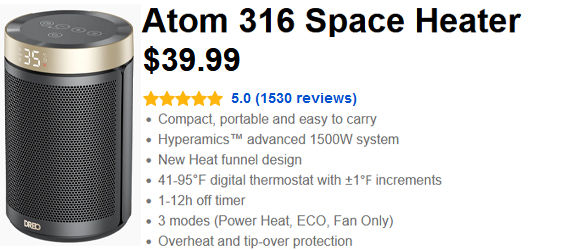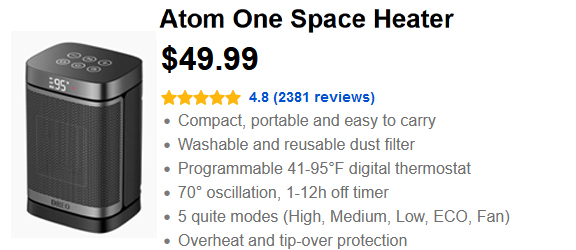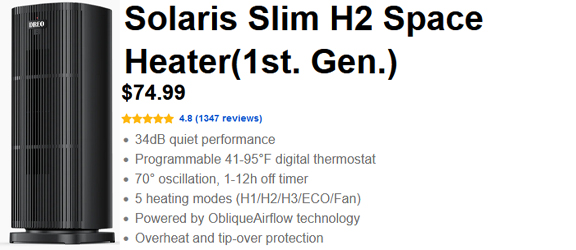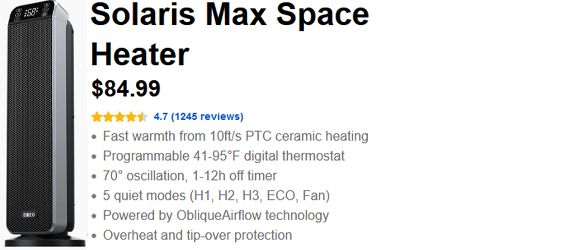
Space heaters are popular devices that can provide extra warmth and comfort in cold weather. They are especially useful for heating up small areas or rooms that are not well insulated. However, space heaters also have a significant environmental impact due to the emission of greenhouse gases and air pollutants. These pollutants can negatively affect air quality, contribute to climate change and harm human health. In this blog post, we will explore the environmental effects of different types of space heaters and how to use them in a more eco-friendly way.
Types of space heaters and their environmental impact
There are three main types of space heaters: electric, gas and wood. Each of them has its own advantages and disadvantages in terms of efficiency, cost and environmental impact.
Electric space heaters
Electric space heaters are powered by electricity and use a heating element or a fan to distribute heat. They are convenient, portable and easy to use. However, they are also the most energy-intensive type of space heaters. According to the U.S. Department of Energy, electric space heaters can consume up to 1500 watts of electricity per hour, which is equivalent to running 15 incandescent light bulbs1. Moreover, depending on the source of electricity, electric space heaters can also contribute to greenhouse gas emissions. For example, if the electricity is generated from coal-fired power plants, electric space heaters can emit about 1.5 kg of carbon dioxide (CO2) per hour2.
Gas space heaters
Gas space heaters are fueled by natural gas or propane and use a burner or a catalytic converter to produce heat. They are more efficient and cost-effective than electric space heaters, as they can heat up a larger area with less energy. However, gas space heaters also have some drawbacks. They require proper ventilation and installation to prevent gas leaks, carbon monoxide poisoning and fire hazards. They also emit nitrogen oxides (NOx), carbon monoxide (CO) and other air pollutants that can worsen indoor and outdoor air quality and cause respiratory problems. According to the Environmental Protection Agency, gas space heaters can emit up to 0.4 kg of NOx and 0.03 kg of CO per hour3.
Wood space heaters
Wood space heaters are fueled by wood logs, pellets or chips and use a combustion chamber or a stove to generate heat. They are the most traditional and natural type of space heaters, as they can create a cozy and rustic atmosphere. However, wood space heaters are also the most polluting type of space heaters. They produce large amounts of particulate matter (PM), carbon monoxide (CO), volatile organic compounds (VOCs) and other toxic substances that can impair lung function and increase the risk of cancer. According to the World Health Organization, wood space heaters can emit up to 7.5 kg of PM and 15 kg of CO per hour4.
How to use space heaters in a more eco-friendly way
While space heaters can provide warmth and comfort, they also have a significant environmental impact. Therefore, it is important to use them in a more eco-friendly way. Here are some tips to reduce the energy consumption and pollution of space heaters:
- Choose the right type and size of space heater for your needs. Electric space heaters are best for small and well-insulated areas, gas space heaters are best for large and poorly-insulated areas, and wood space heaters are best for outdoor and occasional use.
- Use a thermostat or a timer to control the temperature and duration of space heating. Set the temperature to the lowest comfortable level and turn off the space heater when you leave the room or go to sleep.
- Maintain and clean your space heater regularly to ensure its optimal performance and safety. Replace the filters, check the cords, inspect the vents and follow the manufacturer’s instructions.
- Use renewable energy sources or energy-efficient devices to power your space heater. For example, you can use solar panels, wind turbines or batteries to generate electricity, or you can use LED bulbs, smart plugs or power strips to reduce electricity consumption.
- Improve the insulation and ventilation of your home to reduce heat loss and improve air quality. For example, you can use weather stripping, caulking or curtains to seal the gaps and cracks, or you can use fans, windows or air purifiers to circulate the air.
Space heaters are convenient and useful devices that can help you stay warm and cozy in cold weather. However, they also have a significant environmental impact that can affect your health and the planet. By choosing the right type and size of space heater, controlling the temperature and duration of space heating, maintaining and cleaning your space heater, using renewable energy sources or energy-efficient devices, and improving the insulation and ventilation of your home, you can use space heaters in a more eco-friendly way. Stay warm and green!





